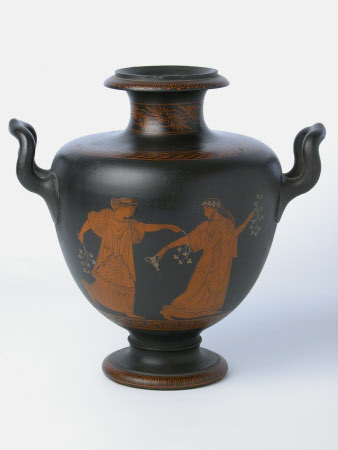Vase
probably Wedgwood
Category
Ceramics
Date
1770 - 1790
Materials
Basaltware
Measurements
235 mm (Height); 240 mm (Diameter)
Place of origin
Staffordshire
Order this imageCollection
Saltram, Devon
NT 870783
Summary
Vase, black basalt, the form based on an ancient Hydria, low pedestal foot, flattened shoulder with short flaring neck and two upright curved handles, probably Wedgwood & Bentley, Etruria, Staffordshire, c1770-80; painted with encaustic enamels in red and white with male and female classical figures and decorative bands of gadrooning at the foot, ‘Greek key’ pattern to lower body, stylised foliage to the shoulder and neck, with an egg and dart border to rim.
Full description
This vase is one of three similar pieces at Saltram that might have been used as a group or ‘garniture’ to decorate a mantelpiece, cabinet or bookcase. Josiah Wedgwood described them as ‘fit Ornaments for the nobelest Apartments.’ Wedgwood had a large collection of sourcebooks for Classical designs at his factory in Etruria. Most influential was the catalogue of the enormous collection of ancient Greek vases amassed by Sir William Hamilton during his career as a royal diplomat in Italy. This provided a wealth of designs for Wedgwood and his partner Thomas Bentley to use so clients could own their own ‘Hamilton vases’ at a more affordable price than an ancient original. In his 1774 catalogue, Wedgwood describes his vases as ‘copied from the antique with the utmost Exactness…but more especially in the most choice and comprehensive Collection of Sir William Hamilton.’ This vase is decorated with encaustic painting, which was patented by Wedgwood in 1769. It was used primarily to imitate ancient the red figure painting on ancient Greek and Italian vases. The matt colours were applied onto unglazed black basalt (a type of stoneware) using a brush – most often in red, black and white, but occasionally in contrasting colours such blue, green and pink. Wedgwood claimed that the figures on the vases were copied from a variety of sources: ‘Gems, antique Paintings, and Bas-reliefs; and are executed with great Care by the best Hands we can employ.’ Because he patented the encaustic formula, Wedgwood had to reveal the materials he used, which included a fine slip of unaker, described as ‘Cherokee clay’, into which coloured pigments were mixed. Unaker is a fine, brilliant white mineral used for millennia by the Cherokee for ceramics and architectural uses. It was also a highly symbolic material to the Cherokee and crucial in its diplomacy. It was first brought to Britain illicitly in 1740, when the production of porcelain was in its infancy. In 1767, to ensure his supply to this material, Josiah Wedgwood hired the merchant Thomas Griffiths to travel to Keowee, a Cherokee mother town in the British Province of South Carolina. He returned with five tons of unaker for Wedgwood at vast expense (more than £50,000 today), which was then used for the production of encaustic decoration and later, he claimed, for the development of his jasperware body. The Parkers were enthusiastic customers of Wedgwood, but it is not known which family member purchased the encaustic vases at Saltram. In 1775 Montagu Edmund Parker purchased ‘urns’ from Wedgwood & Bentley in London. The Wedgwood archives contain a letter written by him on 4 April 1775 from his home, Whiteway, to “Mr. Bentley” at Wedgwood’s Warehouse in Greek Street, London, beginning: ‘On your telling me that you had sent the Urns, into the Country according to the Direction given you, I was not, as you may suppose, a little disappointed in not finding them here on my arrival.’ Theresa Parker also refers to similar objects in a letter to her brother on 24 August 1775: ‘I have just been ornamenting a glass case you have seen in my Dressing Room with China. The principal shelf with the only China that deserved to be called ornamental I mean the Biscuit, and the others with figures of the same sort of material, which confirms my opinion in favour of the French, the lower shelf being the unglazed Dresden Dogs hunting stags and Bears, etc. not bad and the Upper Row Chinese Models – very bad, but not bad of their kind. I think I also I may place some of the Wedgewoods best unglazed Black Ware, for that may bear a Comparison with the French.’
Provenance
Transferred to The National Trust as part of the endowment provided by Montagu Brownlow Parker (1878-1962),5th Earl of Morley
Makers and roles
probably Wedgwood, potter
References
R. Ruthie Dibble and Joseph Mizhakii Zordan, "Cherokee Unaker, British Ceramics, and Productions of Whiteness in Eighteenth-Century Atlantic Worlds", British Art Studies,, Issue 21, https://dx.doi.org/10.17658/ issn.2058-5462/issue-21/dibblezordan Reilly 1995: Robin Reilly, Wedgwood: The New Illustrated Dictionary (Woodbridge: Antique Collectors Club, 1995), p.103. Wedgwood and Bentley : Free Download, Borrow, and Streaming : Internet Archive; Mallet, John. Wedgwood’s Early Vases, Country Life, 9 June 1966/
